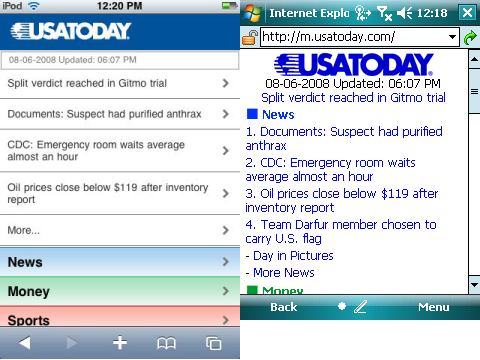I noticed there was an update for my HTC S710 (Vox) Windows Mobile smartphone on the HTC Support site. The upgrade does NOT move the phone to 6.1. However, based on the changes in version numbers, the update may be fairly important. My ROM version went from 1.15.405.2 to 1.34.405.1. The radio version went from 4.1.13.37_02.83.90 to 4.1.13.54_03.10.90. Windows Mobile itself remained at version 6.0 (not 6.1).
Category: Windows Mobile
Microsoft Windows Mobile Pocket PC, Pocket PC Phone Edition, and Smartphone
-
Back to Basics: The Mobile Browsing Experience

Most web pages are designed to be viewed on a desktop or notebook computer. Looking at these pages on a small screen phone is like looking at a mountain range through a pinhole. It is not a good viewing experience. Some web site owners and designers now understand that many people look at their pages on-the-go on their phones and other small screen mobile devices. Unfortunately, there are tremendous differences between the various browsers on various devices.My first web-enabled phone had a monochrome display that placed black characters on a green-ish tinted background like the green-screen CRTs from decades ago. It supported the Wireless Access Protocol (WAP) which simply placed characters on the tiny screen and assumed your main input was a 12-key phone keypad. These days it is still considered the most basic format supported and you still see addresses like wap.ao.yahoo.com. It has the advantage of being lightning fast because it is usually text with little formatting. It also works on almost every mobile device running today.
Many of today’s so-called smartphones use mobile versions of familiar desktop browsers such as Internet Explorer and Opera. These smartphone browsers often are missing some of the functions of their desktop counterparts but can deliver a limited but still useful web experience if a website is designed for the mobile browsers limitations.
Finally, there are mobile browsers that deliver near desktop experience on a small screen. Opera Mobile and the Apple iPhone’s Safari deliver outstanding mobile web browsing experiences. However, as good as these browser are, the pinhole viewing effect still exists. Fortunately, some websites are now designed to identify the different mobile browser types and deliver optimized web pages for the different platforms. The USA Today newspaper online site is a good example. If you type usatoday.com in an iPhone (or iPod touch) Safari browser, it automatically redirects you to the iphone.usatoday.com site optimized to look and work best with an iPhone. Typing the same usatoday.com on a Windows Mobile smartphone, on the other hand, sends you to the simpler but still useful m.usatoday.com formatted for use with most of the web browsers used by smartphones using various mobile operating systems.
You can see two versions of the same USA Today web home page above. The screen on the left is the page formatted for an iPhone. The screen on the right is formatted for most mobile web browsers. This specific screen capture came from a Windows Mobile Professional Edition smartphone with a touch screen.
Incidentally, the one thing you rarely see is the ill-fated attempt to create mobile specific web domains ending in the .mobi name suffix. The common naming conventions for mobile friendly websites use prefixes such as wap. (wap.oa.yahoo.com), mobile. (mobile.msn.com), and m. (m.digg.com). Sites designed specifically for the iPhone sometimes use the prefix iphone. (iphone.usatoday.com). There are other variants such as a trailing /i path after the domain name (friendfeed.com/i). So, it can be a challenge to figure out what the correct mobile friendly webpage name is if the site does not auto-identify and redirect you to the correctly formatted site as USA Today does.
The good news though is that browsing from your phone or other small screen devices is on the radar of web site ownes and developers. And, it has resulted in a much improved web browsing experience when on the go.
-
Torch Mobile Iris Browser Based on Webkit for Windows Mobile
I just read about the…
Torch Mobile Iris Browser 1.0.12 preview
…for Windows Mobile 5 and 6 on Jason Langridge’s blog. The preview release is a free download. I don’t see any mention of what happens after the browser leaves its preview release period though. I might try it, but I am tired of fussing with registration and beta-timeouts and other nonsense. My iPod touch Safari web browser works fine now. I’ve stopped browsing the web on my Windows Mobile devices. Not sure a new untested browser with an uncertain future is worth fussing with.
-
Does the New T-Mobile SideKick Foreshadow the end of Windows Mobile?
Microsoft isssued a long press release about the new T-Mobile Sidekick (its developer, Danger, is now a Microsoft subsidiary). Here are the two main paragraphs from the press release:
The new Sidekick features key software improvements including support for video capture, playback and sharing; wireless stereo music and media sharing via Bluetooth; quick friend search and optimized group chats in instant messaging (IM); customizable Web browsing; and universal search across all phone applications and data. In addition, the phone’s shell is customizable, creating a unique look for every device. The result is a Sidekick that is fun to use and showcases the owner’s individuality and style.
“Mobile phones aren’t soulless devices. They’re personal expressions and our lifeline to the people that matter to us as we navigate through all of life’s moments,†said Roz Ho, corporate vice president of Premium Mobile Experiences at Microsoft. “Playing such a significant role in our lives, mobile phones should reflect our individual style. T-Mobile clearly understands this, and we’re very excited about what the new Sidekick will offer consumers.â€
At $149, after a discount and mail-in rebate, it comes in below the price of the low-end iPhone. Although it doesn’t have all the features of a Windows Mobile phone (WiFi, for example), it probably has enough features for 99% of people who want fun non-enterprise features (IM, camera, web browser, email, and a QWERTY keyboard). I commented a while back that I think Windows Mobile 7 may be the end of the line or near the end of the line for the WiMo platform. So, take a close look at the new Sidekick. It may be the path that replaces WiMo at Microsoft.
-
Microsoft Live Mesh Mobile Web Interface

Microsoft Live Mesh is one of several cloud storage services offered by Microsoft (along with Skydrive and Office Live Workspace). One interesting feature of Live Mesh is its web interface for mobile devices. I looked at it from both a TyTn (Windows Mobile Professional Edition 6.0) and iPod touch (2.0 firmware) Both allowed retrieval and photo upload (but not the uploading of other file types). However, when I tried to upload a photo from my TyTn, it was unable to see any photos on the storage card. It could only see files in system RAM rendering this feature near useless. However, I uploaded one of the sample images left in system RAM. And, it did indeed get uploaded to Live Mesh and was visible on my PC. -
Windows Mobile Gets No Respect: iPhone Gets Credit for Touchscreen Revolution
Information Week trumpets…
iPhone: Catalyst For Touchscreen Revolution
Never mind that Windows CE/Windows Mobile devices have been continuously providing touch screen devices since 1996. And, of course, the Apple Newton essentially defined the concept of PDA in 1993.
But, hey, I’ll give credit where credit is due. Apple did the touch screen right. I know that I much prefer to use my iPod touch for a variety of information retrieval tasks (web browsing, reading email, etc.). But, I still prefer to use my Dash smartphone for writing email, creating a calendar event, or entering contact information.